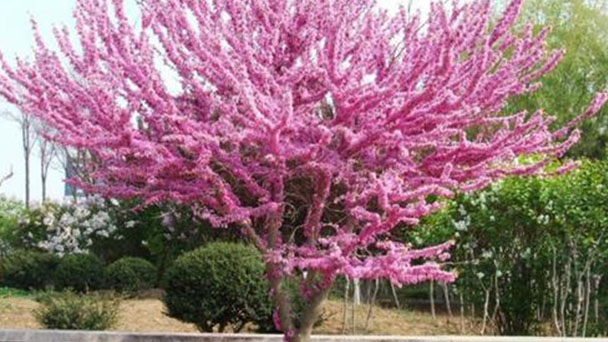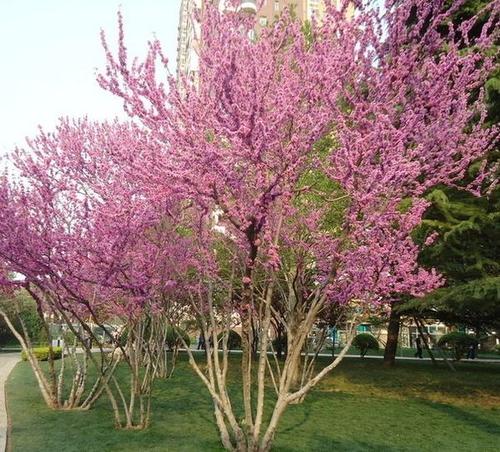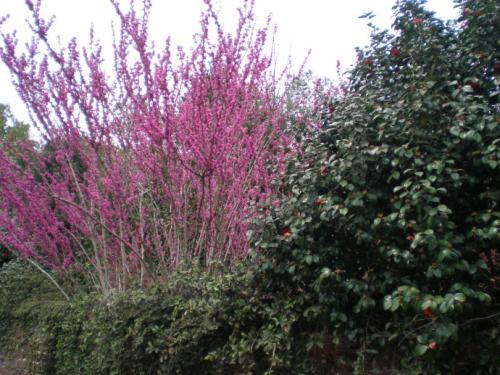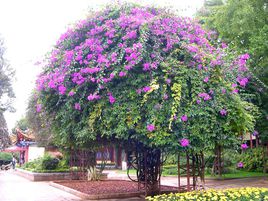Chinese redbud profile
Written by Maggie
Mar 24 2021

Cercis chinensis, also called Chinese redbud, is a deciduous tree or shrub. It is native to China. It likes light, has a certain cold resistance, likes fertile, good drainage of the soil, not to be flooded. Chinese redbud has strong tillering, resistance to pruning. Chinese redbud flowers can be used as medicine, and their seeds are poisonous.
Chinese Redbud picture

Morphological characteristics of Chinese Redbud
Chinese redbud is a clustered or solitary shrub, 2-5 m tall; The bark and branchlets are pale white. Leaves are papery, suborbicular or triangular-orbicular, 5-10 cm long, wider to longer, apex acute, base shallow to deeply cordate, both surfaces usually glabrous, green, petiole purplish, margin membranous, visible when fresh.
Flowers are purplish red or pink, 2-10 in bunches, clustered on old branches and main stems, especially the main fascicles more, the more to the upper young branches flowers less, usually before the leaves open, but the young branches or young plants flowers and leaves open at the same time, flowers 1-1.3 cm long; Pedicels are 3-9 mm long;Deep purple markings at base of keel flap; The ovary is pale green, buds glabrous, later densely pubescent, ovules 6-7.
Chinese redbud pod is oblong, green, 4-8 cm long, 1-1.2 cm wide, wing width ca. 1.5 mm, apex acute or short acuminate, beak thin and curved, long acuminate, symmetrical or nearly symmetrical stitches on both sides; The fruit neck is 2-4 mm long;Seeds 2-6, broadly oblong, 5-6 mm long, ca. 4 mm wide, dark brown, bright. Flowering period: March to April; Fruit: period August - October.
Chinese Redbud growth Habit
Chinese redbud is a tree with a warm belt and is hardy, light loving, slightly shade tolerant, likes fertile, good drainage of the soil.
Chinese redbud has strong germination and resistance to pruning.
Distribution scope of Chinese Redbud
Chinese Redbud is located in the southeast of China, reaching Hebei in the north, Guangdong and Guangxi in the south, Yunnan and Sichuan in the west, Shaanxi in the northwest, Zhejiang, Jiangsu and Shandong in the east and other provinces.Is a common cultivated plant, mostly planted in garden, house side, temple street, a few born in dense forest or limestone areas.
Propagation method of Chinese Redbud
Sow
From Month to October, mature pods were collected, seeds were taken out, and buried in the dry sand for overwintering in the shade. Sow seeds from late March to early April of the next year, and conduct seed treatment before sowing. Soak the seeds of Chinese Redbud in 60℃ warm water, then continue to soak for 3 to 5 days after the water cools. Cold water should be changed once a day. After the seeds are expanded and absorbed, they should be placed in an environment of 15℃ to accelerate the germination. The seeds should be watered once to twice a day with warm water, and then planted in the seedbed after being exposed to white. For true leaves when transplantable nursery, bed with loose fertile loam had better. For ease of management, the planting should be narrow, 60 cm wide and 40 cm narrow, with plants 30 cm to 40 cm apart. Seedling period is not cold, winter with plastic arch canopy protection over the winter.

Division
Chinese Redbud root easily produces tillers. Before germination in October or spring, it is easy to survive by cutting the tiller seedling and the lateral root connected with the mother plant and planting it again. The autumn plants should be protected over winter by false planting, and the spring planting in March. Generally the second year can flower.
Layering
In the growing season, layering can be carried out, and spring March to April is better. Aerial strip method can be selected 1 to 2 years old branches, cut with a sharp knife and ring stripped bark about 1.5 cm, exposed xylose, root powder liquid (diluted according to the instructions) coated on the top of the carved part about 3 cm, to be dry with a tubular plastic bag set in the carved part, filled with loose garden soil. After watering, tie both ends. Check after 1 month, if the soil is too dry to hydrate, root after cutting another plant.
Thicket type trees can be selected as peripheral soft, 1 to 2 year old branches to the base of the incised, coated with root powder liquid, after a sharp bend buried in the earth, the upper pressure masonry fixed, the top tip can be supported by sticks upright. Generally in the second year in March, divide another plant. Some branches do not root, can continue to bury pressure, the second year can root.Continue to bury pressure, the second year can root.
Cuttings
In the summer growing season, cut the current year young shoots as cuttings, inserted in the sand can also survive, but not used in production.
Grafting
Chinese Redbud with strong growth can be used as rootstock, but the cold resistance of giant redbud is not strong, so it should not be used in northern areas. Make scion with buds or branches of excellent varieties such as Canadian redbud, scion requires pure varieties, vigorous growth, choose plants without pests or less pests to enrich branches to the periphery of the sun. Cut off leaves after the collection of scion, timely grafting. This can be done by grafting in April to May and August to September, and by budding in July. If the weather is dry, one to two days before grafting should be permeable, to improve the survival rate of grafting.
Chinese Redbud main Value
Medicinal
Chinese Redbud bark can be used as medicine, with the functions of clearing away heat and detoxification, promoting blood circulation and qi, relieving swelling and pain, treating postpartum blood pain, treating sore, swelling and poison, and curing pharynx. Flowers can cure rheumatism bone pain.
Economic
The wood grain is straight, the structure is fine, can be used for furniture, building, etc.
Chinese redbud is suitable for planting in front of courtyards, lawns, rocks and buildings. It can be used for landscaping of the community and has good ornamental effect.

Latest Updated
- Benefits of Bugleweed - 7 Science-backed Health Benefits
- Bugleweed Dangers & Side Effects - Is It Poisonous?
- How to Plant Evergreen Trees - What You Should Know
- When to Plant Evergreens - Grow Guide for Evergreen Trees
- 12 Wonderful Evergreen Shrubs for Your Garden
- 12 Popular Evergreen Plants with Pictures for Beginners
- When And How To Prune A Lilac Bush Like a Pro
- How to Grow & Care for Lilac Vine (Hardenbergia Violacea)
- Japanese Lilac Tree (Syringa Reticulata) Care & Propagation Guide
- Shumard Oak Pros and Cons - What to Know
Popular Articles
- Winter maintenance of Antirrhinum Majus
- How to Grow Terminalia Mantaly Tree
- How to Grow and Care for Crossostephium Chinense
- How to grow Antirrhinum Majus in spring
- Peristeria Elata (Dove Orchid) Profile: Info & Care Guide
- Underwatered Snake Plant (Sansevieria Trifasciata) - Signs And How To Fix
- How to Care for Brazilian Jasmine Plant (Mandevilla Sanderi)
- How to Grow & Care for Graptopetalum Purple Delight in Summer
- Rosa Chinensis (China Rose): Plant Growing & Care Tips
- How to Care for Baby Sun Rose (Aptenia Cordifolia)